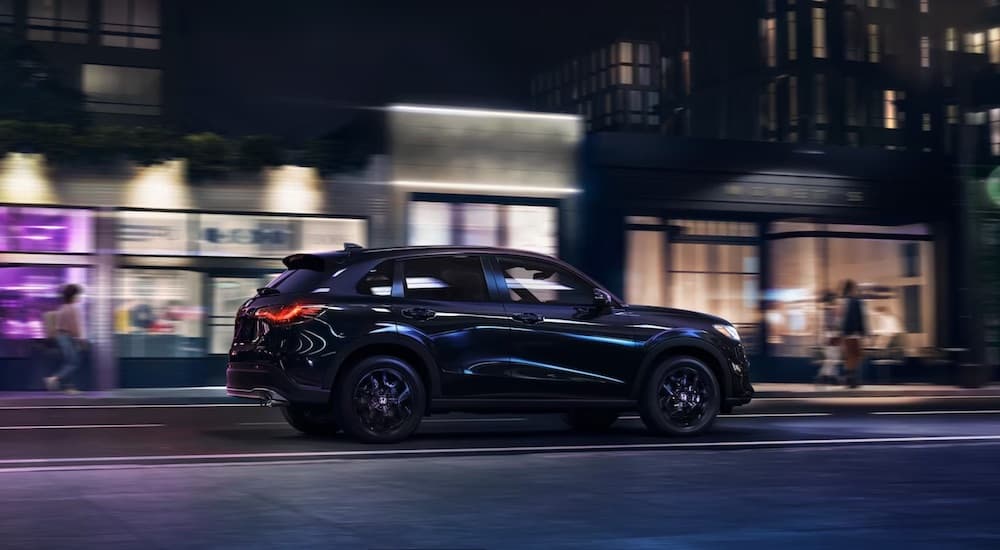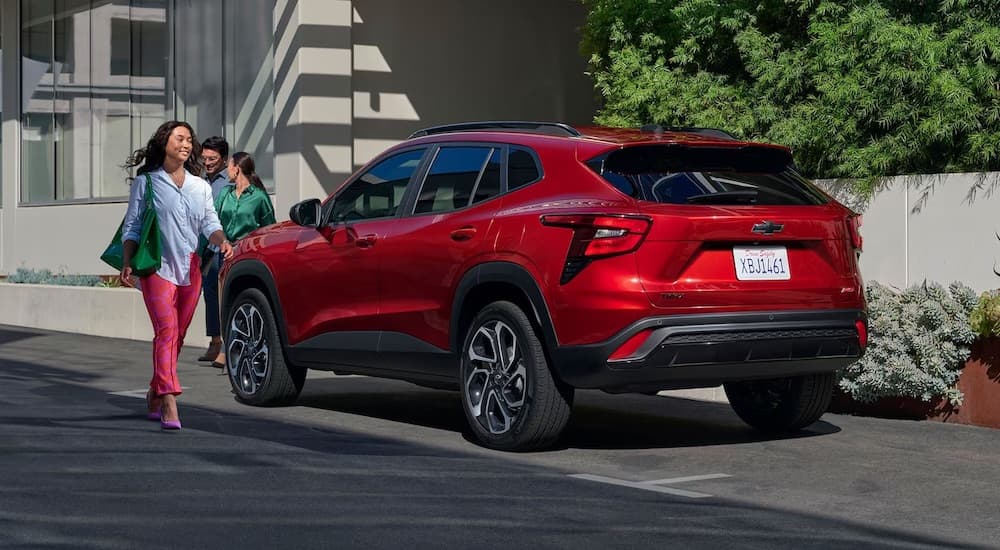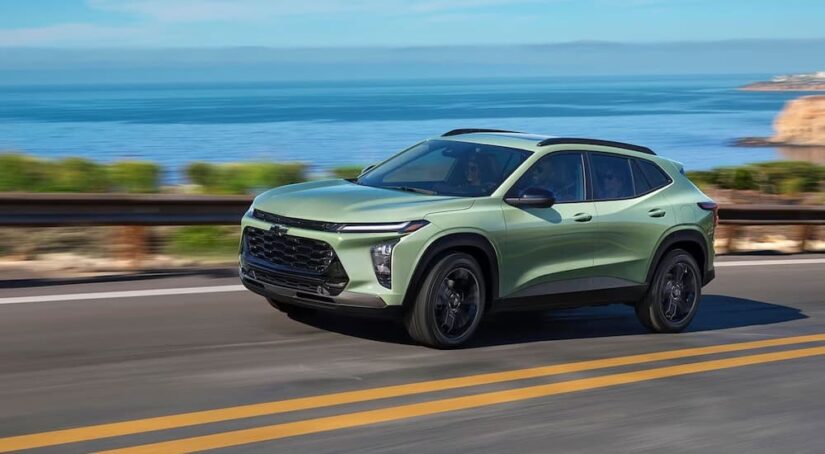The world of the crossover is not for the faint of heart—a constant fight to claim the title of top CUV. In the battle of the urban crossovers, two formidable contenders duke it out to see who will take the fast lane to victory and who will get the boot. So, in a match-up of the 2024 Chevy Trax vs 2024 Honda HR-V, who will claim it all?
Chevy and Honda are well known for their long, rich histories of producing vehicles that showcase innovative designs and incredible contributions to the industry. Both of these CUV entries originated around the same time, and they share many of the same features, so it can be challenging to distinguish which is the better choice—but that’s what we’re here for, so let’s get into it.
The Road to the 2024 Chevy Trax
Introduced in 2015, the Trax is essential to the Chevy lineup. Its compact size makes it a fantastic option for someone who wants the maneuverability of a sedan but a capability closer to that of an SUV. When the Trax was first introduced, it came in three trims—the LS, LT, and LTZ—and was available as either front- or all-wheel drive, rounding out its capabilities.
Designated an urban crossover, it was—and still is—ideal for individuals or families who want a safe, affordable option with plenty of high-end features. Since the beginning, the Trax has been well-equipped, featuring things like a touchscreen display, navigation, and even Wi-Fi hotspot capability. Most importantly, the Trax ranks high on the safety scale, making it a fantastic option in which you can feel confident.
Despite being on the US market for less than ten years, the Trax has garnered its fair share of attention in foreign markets. Proving its worth overseas, the Trax finally made its way here, becoming an impressive competitor in the ever-growing CUV segment. Fast-forward to 2024, and the Trax continues to prove that its move to the US was a good idea.
Still sporting impressive maneuverability thanks to its compact sizing, the Trax is surprisingly spacious inside. It offers a relatively comfortable ride and plenty of tech features, and it gives the rest of its segment a run for its money. With so many CUV options and the market continuing to grow with time, it is interesting to see where this model lands and how it stacks up against one of its biggest competitors: the Honda HR-V.
Journey to the 2024 Honda HR-V
The Honda HR-V has been on the market for much longer than the Trax, but it’s had a rocky trip to get where it is today. The HR-V has been on the market since 1998, but only internationally, not locally. It did a great job of impressing our neighbors but took its sweet time making its way to the good ole U-S-of-A. Once here, though, it excelled and proved an impressive match for the Trax.
After a brief hiatus in 2006, the HR-V was reintroduced at the time that the Trax emerged, making their paths thereafter quite similar. With several trim levels and both front- and all-wheel drive, the HR-V seems like a symbolic twin of the Trax. Coming in below the CR-V, the HR-V offered an ideal sizing for anyone wanting something that could handle daily errands and easily navigate busy streets or traffic.
Inside, Honda employed some of their magic to make an inviting interior with clever features designed to get the most out of this model; for example, features like Magic Seats allowed the cabin to open wide for maximum cargo space. The HR-V was an excellent option for families, and it continues to impress today. A versatile interior and plenty of seating make this CUV one to consider for whatever plans lay ahead.

Comfort and Convenience
Both CUVs emphasize comfort and convenience, packing in the most they can in every nook and cranny. The Chevy Trax can fit up to five occupants, with flexible rear seating that offers a 60/40 fold flat seat for ultimate adaptability. With an impressive 54.1 cu.ft. of max cargo space, the interior of the Trax feels airy, open, and comfortable for everyone.
Depending on the trim choice, the Trax has either an 8.0- or 11.0-inch touchscreen display. Chevy ups the game with wireless Apple CarPlay and Android Auto compatibility on all trim levels. Other desirable standards include Wi-Fi hotspot capability, remote keyless entry, and a plethora of top-notch safety features: the standard Chevy Safety Assist suite includes Lane Keep Assist with Lane Departure Warning, Forward Collision Alert, and IntelliBeam auto high beams. An added bonus is Teen Driver mode, a unique system designed for new drivers who want to build good driving habits.
The Honda HR-V also seats five but offers slightly less passenger room than the Trax. Occupants might feel slightly more cramped in the HR-V, although the Honda does make up for it with slightly more cargo space; when exploiting the Honda’s flexible seating configurations, a total of 55.1 cu.ft. of cargo space can be achieved, giving it a slight advantage over the Trax. However, when the seats are in use, the Trax regains the lead for cargo and passenger space alike.
The HR-V offers a well-equipped and comfortable interior but lags in accoutrements. Depending on the trim, the HR-V provides a 7.0- or 9.0-inch color touchscreen display as the hub of connectivity and entertainment. The HR-V comes standard with Apple CarPlay and Android Auto—a feature most CUV buyers expect nowadays—but wireless versions of these are only standard on the top-tier trim.
The HR-V doesn’t offer Wi-Fi capability, but both CUVs offer wireless phone charging, so as long as you have a solid data plan, you can still easily connect to the HR-V. From there, the HR-V holds its own with its safety features, keeping pace with the Trax via its Honda Sensing suite. The HR-V offers a few extras that the Trax fails to provide; for example, features like Traffic Sign Recognition are standard on all three trim levels—an excellent addition to the HR-V.
Performance and Capability
CUVs are held to a different standard in performance than their bigger siblings, the SUV. However, that does not mean that CUVs aren’t expected to still offer some sort of performance, even if it isn’t towing and hauling. A vehicle’s performance centers around what is under the hood, and in the Trax it is a turbo engine that produces 137 hp and 162 lb-ft of torque. Conversely, the HR-V has an inline-four that pumps out 158 hp and 138 lb-ft of torque. The difference here shows that the HR-V has more spirit, but the Trax offers more strength.
Performance isn’t just what engine there is and what it produces, but also what transmission disseminates that power to the road. In the Trax, it is a six-speed, and in the HR-V, it is a CVT. Some people love the snappiness of gear shifting, but even six phases is a tad sparse. On the contrary, many people love the fluidity of a CVT since it means a seamless acceleration every time, so the HR-V has the leg-up here.
Although neither CUV can claim to tow the most or haul the most (since neither can really tow at all), their bragging rights boil down to their performance on the road. The Trax has done a shockingly good job at wowing enthusiasts with its dependable performance—even on steep inclines and tight turns—courtesy of its enhanced torque. Although the HR-V can go faster, the Trax will provide a much more engaging experience if that is what you want.

This CUV Takes It All
The 2024 Chevy Trax and the 2024 Honda HR-V are great options, with roomy interiors and compact sizing for easy maneuvering. Decked out with the latest safety tech and a plethora of convenience features, it is difficult to not appreciate what both CUVs offer… but there must be a winner, and there must be a loser—so with that in mind, I’d pick the Trax.
With more trims to choose from (including the adventurous ACTIV), the Trax offers more customizability than the HR-V. It has more standard features, its interior space is better proportioned, and its performance is more focused on the environments where a CUV is going to be driven most. It isn’t a decisive win, but it’s a win nonetheless.



